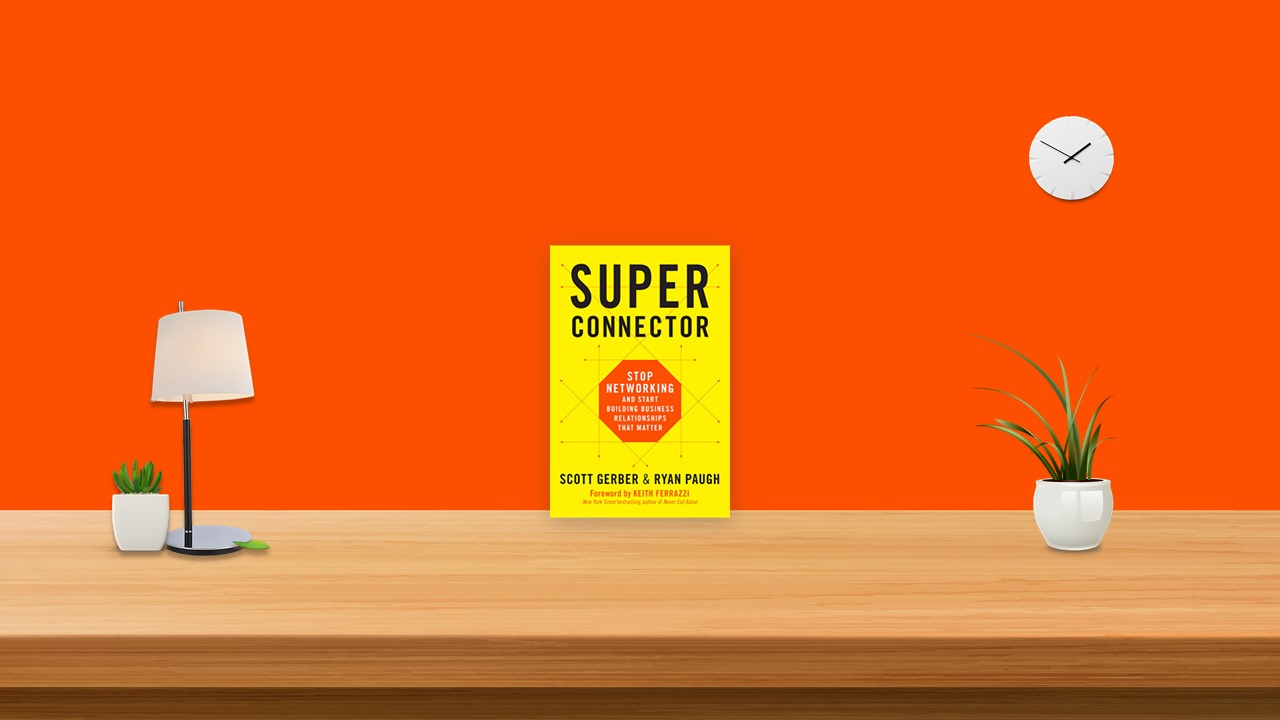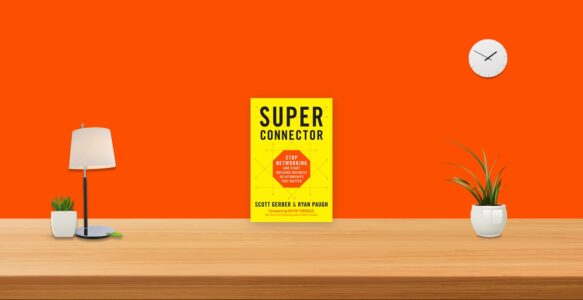The End of Networking
Here’s the truth: The number of contacts and followers you have online does not trump real relationships. Being virtually or offline “connected” is not in itself valuable. Social capital cannot be measured in likes and shares. Instead, you have to acquire social capital and build trust and meaningful relationships through the right conversations, actions, and value exchanges with the right people. (By value exchange, we mean information, education, mentorship, a resource, or a connection—literally, a place where value is exchanged.)
Instead of asking, “How do I solve this business challenge?” a Superconnector thinks, “Who do I know awho can help me solve this business challenge or directly connect me with the right people?” A Superconnector knows how to use social capital to solve business challenges with the same ease that a sommelier knows which wine to order with your steamed lobster
Thinking Like A Connector, Not A Networker
Networking” has selfish implications: you want something out of someone else, so you go around making strategic connections. “I think about it as someone who’s trying to build a web of relationships that serve a professional goal, and expand that web as efficiently as possible, and leverage it as efficiently as possible, which is why I feel a little dirty even defining it,” says Wharton professor Adam Grant, the best-selling author of Give and Take: Why Helping Others Drives Our Success.
A connector isn’t in it for anything above the pleasure he or she gets from introducing two people to each other who might benefit from knowing one another. “So it’s not just, ‘Hey, I think you two should meet because one of you can help the other,’” says Grant. “It’s ‘I think you two should meet because you share a common goal. It would be valuable to both of you to know each other.’”
Communicate With Anyone, Anytime, Anywhere
Meeting While Introverted (MWI)
You might think that most great connectors are inherently extroverted people: gregarious, life-of-the-party sorts of people. In fact, there’s a lot of evidence to suggest the opposite.
Don’t be afraid if you aren’t a laugh a minute. Some people estimate that introverts constitute one-third to half of the US population. Many are terrific Superconnectors. Everyone needs to learn how to have a conversation, whether they are introverted or extroverted. The content doesn’t change; the strategies to get there do. Introverted Superconnectors don’t hide; they simply play to their personality type. They figure out what works best for them and then use it to the maximum effect. Play to your strengths.
Context, Context, Context
To be successful at connecting, you must create a full profile of the person you are talking to. You want to determine who this person really is. You’re also determining if they’re an okay person or an “amazing” person whom you would want to invest considerable time and energy in over the years.
Most people think of life in black and white terms. Connectors are more interested in the gray zones, in the subtle nuances that make us all unique. What are the other person’s likes and dislikes, the things you don’t find on their Facebook or LinkedIn profiles? If someone says to you, “I like asparagus,” the proper response is not “Great!” but “Why? What is it about those skinny green stalks that speaks to you?”
Your goal in any conversation is to go beyond surface level, to get context and find out something remarkable about the person that will help you remember them later on. You hold the world record for underwater breathing? Amazing! How’d you get into that?
If you approach a celebrity or public figure as a fan, you’ll be treated like one. Their guard goes up; so many people want something from them. So if you treat a celebrity like a celebrity, you should prepare for a minimal, surface-level exchange that’s likely to last a fraction of a moment. But if you treat them like a person—a real person, who eats and sleeps and poops—the likelihood of a real, context-rich exchange increases. People want to be treated like regular people, even if they don’t admit it publicly. Most people want to have a conversation, too. They’re often just afraid to.
Good Questions, Bad Questions, Questions In-Between
Why “How Can I Help You?” Is the Worst. Question. Ever.
Because “How can I help you?” is broad and unclear. It also assumes that the other person is already sold on the fact that you’re a helpful person to know. Finally, and perhaps most important, today the phrase has been espoused by so many blogs and gurus, it feels stale and icky and screams “marketing tactic!” It’s another one of those concepts that started with great intentions, but like every other platform or tool that worked, people found a way to turn it into sales-speak or a code word for “Let me ask if you need anything, so it won’t ‘seem’ sleazy or off-putting when I immediately ask you for something right afterward” or “when I make you feel awkward if you don’t ask me the same question, which is actually my real intent.”
Vanessa Van Edwards, the professional people watcher we met earlier, feels similarly about that question, as well as “What do you do?” “It’s a social script,” she says. “We answer as if it’s memorization. If people like what they do, they’ll find a way to tell you about it. If they don’t, they’ll find a way to avoid it, and that’s the best thing you can learn about someone.”
However, Van Edwards found that asking “What are you working on?” gets amazing responses. People light up like the electric grid when you ask them that. They lean in toward her and visibly animate. Not only does “What are you working on?” sound more like a casual conversation, but it also puts you in the driver’s seat to listen and discover opportunities where you can provide value. “The sweet spot is finding conversation starters that are easy to access,” she says.
Reminder: You are not there to talk about yourself. You are trying to learn what the other person is about. This doesn’t mean you just pepper them with questions, but it means you aren’t there to wax poetic about yourself and your many accomplishments. Eventually, you won’t even realize you’re doing it. It will come naturally to you.
Again, if a question ends with a yes or no statement, then you have not done your job.
Introductions: Dos and Don’ts
How to Make an Intro
A good introduction offers context, is matter-of-fact without being unnecessarily verbose, lays out the goals and mutual value—and explains how to accomplish all of this in either an in-person one-minute overview or a short email that actually gets read.
Bad: John Smith knows everything about sales. He’s one of the most awesome people I know!
It says nothing. Neither party has any idea why he should meet the other. Why should either one waste his time? What will he get out of it? What’s the goal? Compare it to:
Good: John Smith is a chief revenue officer who has delivered consistent sales growth for his company in the Enterprise SaaS space for about ten years.
The Double Opt-In
One mistake new connectors make is ambushing someone. They’re so eager to get started, they blindly reach out. This is a colossal no-no. Indeed, the very first rule of successful introduction making is something called the “Double Opt-In,” a term coined by Adam Grant.
The Double Opt-In is exactly as it sounds: a connection between two people who both agree to it. Only in very select circumstances is it okay to make a blind introduction, and then only if you have such a strong level of confidence that the connection you’re about to make is something both parties can’t live without.
Every introduction should operate on a case-by-case basis, but you should always use your head. If it’s someone you know well, you can just go for it. But if it’s more nebulous, then you should be conscious of the person’s time.
Obviously, if two people are in the same room, you have three choices: you can introduce them immediately, you can choose not to introduce them, or you can not mention it initially until you get confirmation in a private quick chat with the other person (a verbal opt-in, of sorts).
Google-Proofing Your Reputation
If your online reputation is a disaster, you most likely won’t get the gig. Or the meeting. Or the opportunity. Sad to say, but we are all, each one of us, one bad Google search result away from losing someone’s trust
Still don’t believe us? Check out these stats, courtesy of BrandYourself:
- 82 percent of business decision makers said that presence in search results was an influential factor when vetting people online.
- 42 percent of the online US adults who looked somebody up in a search engine looked someone up before deciding to do business with them.
- 27 percent have searched for someone they met in a professional setting, such as a networking event.
- 23 percent of online US adults who have searched someone online have looked up a coworker.
If you’re not mindful of the way the world perceives you online, then you’re leaving a lot to chance. And what have we learned about Superconnectors? That they do not leave anything to chance, or happenstance, or any other -ance word.


